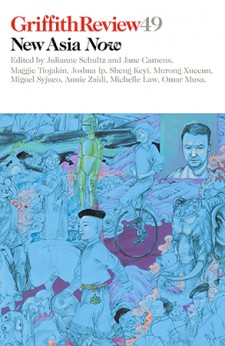Australian icons are rife in our media and our daily lives. We live under  the banner of bronzed sporting heroes and chuckle at nostalgic memories of Skippy the Bush Kangaroo or Blinky Bill the Koala. For those of us encountering Australia for the first time, our knowledge of this country can be mediated by these same icons that we’ve seen or heard about: beaches, babes and barbecues.
the banner of bronzed sporting heroes and chuckle at nostalgic memories of Skippy the Bush Kangaroo or Blinky Bill the Koala. For those of us encountering Australia for the first time, our knowledge of this country can be mediated by these same icons that we’ve seen or heard about: beaches, babes and barbecues.
In this imagined Australian space, we don’t often incorporate the literary achievements of Australian writers, at least not in the spate of tourism advertisements that market Australians as asking their potential visitors ‘where the bloody hell are ya?’
The Griffith Review attempts to intervene in this discourse. Since 2003, they have been a leading literary magazine in Australia. Contributors have included Australia’s Race Discrimination Officer, Tim Soutphommasane, and Filipino writer, Miguel Syjuco. In 2008, Syjuco was awarded the Grand Prize for the Novel in English for the Philippines’ prestigious Palanca Awards and the internationally acclaimed Man Asian Literary Prize for his book, Ilustrado.
Syjuco’s essay, ‘Beating dickheads’ is included in Griffith Review’s edition, ‘New Asia Now Volume 1’. Volume 2 comprises this edition as well. Both volumes make important marks on how we read and what we read. In a normative Australian context, our reading lists and tastes veer towards writing from the west.
‘New Asia Now’ goes beyond this focus. In this current oft-heralded ‘Asian century’, what happens to writing from and about Asia in context to western readership? What about Asian-Australian writers and other Asian writers across their diasporas?
This question haunts both volumes of ‘New Asia Now’. The co-editors for these volumes, Julianne Schultz and Jane Camens, acknowledge that there is no consensus about what ‘old’ Asia might have been. The term ‘Asia’ itself is a manifestation of various political and socio-cultural identities, agendas and realities.
So, what then is ‘new’ Asia? Schultz and Camens contend with this concept by mapping out the complexities inherent in negotiating with, embodying, and investing in Asia. In part, they do this by including Australian writers in ‘New Asia Now’. Including Australia in this mix speaks of the onshore and offshore relations Australia has with its Asian neighbours and citizens, and in fact, gestures towards Australia’s (dis)placement in the Asia-Pacific region.
Including Australia as a part of ‘new Asia’ also provides an opportunity to reflect on the continual consternation towards the supposed ‘Asianisation’ of Australia. Geographically speaking, Australia is situated in the Asia-Pacific region.[1] Because of the cultural ties Australia continues to cultivate towards its British coloniser, such a geographical habitat forms an incongruous relationship between Australia’s dominant British ‘heart’ and Asia-Pacific ‘body’. This incongruity is fleshed out through the ways in which the political leaders of Australia have narrativised their place with and within Asia.
For instance, John Howard’s win of the 1996 election was helped by distancing the Howard government from Paul Keating’s strategies of connecting with Asia and ‘distancing’ Australia from Britain through calls for a republic. This is not to state that Keating’s politics could dissolve tensions regarding Asia/Asians/Asian-Australians and their place in Australia or that Keating envisioned Australia as an ‘Asian’ nation. For instance, in a speech to the Indonesian Foreign Policy Forum on 22 April 1992, entitled Our Common Interest, he described Australia as a ‘European country living alongside Asia’ (cited in Stratton, 1998, p. 194).
Griffith Review’s focus on charting ‘new Asia’ by placing Australia in the mix suggests a proprietal claim on being considered ‘Asian’, or at the very least, as having productive connections with other Asian nations and their creative productions. In this context, the writers in Volume 1 and 2 are born after 1970 and are from Asia, have Asian heritage and/or have something to say about Asia.
A writers’ tour accompanied the publication of ‘New Asia Now’. Their Sydney leg of the tour was held in the University of Sydney’s Law School on 11 August 2015. The event was held in conjunction with the University of Sydney’s China Studies Centre and the Sydney Southeast Asia Centre. For this, three ‘New Asia Now’ writers spoke about their stories and provided context to the motivating factors that drive them to write. Miguel Syjuco, Sheng Keyi (China) and Annie Zaidi (India) were the writers included in this event.
Miguel Syjuco gave voice to the power of the pen in challenging political disenfranchisement. In his piece, he used profanity to trouble the grounds through which our connection to power, change and politics can become operational. In his talk, he discussed this textual technique as a means of playing with form. With this, Syjuco rigorously dissected the Philippine context, especially in terms of how governmentality becomes the vehicle for ‘dickheads’. Profanity is personal and the personal becomes political through Syjuco’s rendering of the Philippine context.
In answer to a question from the audience about what impels him to write in this manner, Syjuco explained that writing for him is like ‘standing at the edge of a precipice, looking out and making the leap forward.’
Keyi also makes the leap forward, especially in terms of leaping into spaces outside of China’s rigid censorship laws. Keyi’s fiction is banned in China and hearing her read her own banned words was a powerful moment.
Zaidi also spoke passionately about her piece, which interrogates the violence enacted on female bodies and the networks of shame and guilt associated with nudity and female vulnerability/exposure. She cited the Indian context for these issues, but opened up the discussion to shed light on the asymmetrical relations of power that gird gender relations across the world.
Each writer spoke about the frustration and the myriad of humiliations, anger and futility in the contexts they seek to dissect. However, each piece was also haunted by hope. The writers brought this to light through their belief in writing as a means to agitate for change.
Perhaps this is what ‘new’ Asia gestures towards: voices and bodies contesting the bounds of legibility through the act of writing and reflection. I read the three writers’ piece as pushing readers out of apathy. My own piece, ‘Bastard Child’ is included in Volume 2 of ‘New Asia Now’. It is the most honest piece I have had the guts to write. And perhaps this is the challenge for us: as readers, writers, thinkers, dreamers, and as citizens of this fractured and tenuous ‘global community’. Let us reach within our guts and to the deepest places within ourselves. Confront their complexity and stretch out in recognition of others’ stories as a means to activate solidarity across borders.
[1] For more information on the ways in which Australia’s geographical borders and placement were determined, see Paul Battersby, 2004. ‘Mapping Australia” Reflections on the permeability of Australia’s northern maritime borders’ in navigating Boundaries: The Asian Diaspora in Torres Strait. Anna Shunakl, Guy Ramsay and Yurio Nagata (eds.) (pp. 13-32). Pandanus Books: Canberra.

